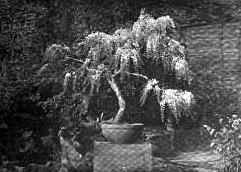|
"Dwarf Japanese Trees (1901):
"SIR, -- In recent numbers of THE GARDEN there have been several articles about the Japanese dwarf trees. I was especially interested in a letter by Mr. George Engleheart published in your June 29 number, where he speaks in favour of the Japanese dwarf trees, and sees the high art in them which they really deserve. 
PIGMY WISTARIA TREE IN JAPAN. "The exhibits made of Larch trees (Larix leptolepis), and which were formed into the shape of storks, junks, &c., ought to have been shown with proper explanations, so that the public was not misled, for here they are nothing more than playthings. No Japanese gentleman would ever look at such figures, and nobody brings these into the same category with our Japanese dwarf trees. They are made by the small nurserymen, who sell the same at night fairs and other public amusements for the masses, and the prices which they bring are certainly not higher than 1s. to 2s. for the very best produced specimens. I have one man amongst my working staff who made me this spring a number of these figures. The way he made them was indeed wonderful, and the figures when finished were equally wonderful, but, as said before, this is nothing more than a mere plaything for children, and it seems a pity that the people in Europe think that these queer outlandish things are connected with higher Japanese horticulture. "As Mr. Engleheart says, a good dwarf tree must be a good representative in miniature of his brother in the forest, and it is just the same with this art as it is with Japanese painting, that the artists observe Nature much closer, and give far better reproductions of Nature than our western artists do! This is a known fact among painters, but the principles of Japanese horticulture have not penetrated sufficiently into the west to be adequately appreciated. "I will give here a very interesting experience which I had in the winter of 1990. I left Japan that winter on a business trip to America, and, as I had often read how much one could make by selling Japanese dwarf trees over there, I took a collection with me and sold them by auction in New York. The selection I made here was already such as I thought would appeal to the American taste, but I also took a number of good specimens with me. The result of the auction was really amusing; trees which a Japanese would never buy were readily sold, and those trees which were good from the Japanese standpoint found very little admiration, and were bought by a number of Japanese dealers of their own art objects, who knew the value and could not resist buying these souvenirs of their beautiful country. This was a good proof that our taste without proper training cannot follow the high ideas of Japanese art, but I have no doubt that all this will be changed, and that Japanese horticulture will have in years to come the same great influence upon western horticulture that Japanese art has had on European art." ALFRED UNGER Yokohama (L. Boehmer and Co.). 1 |